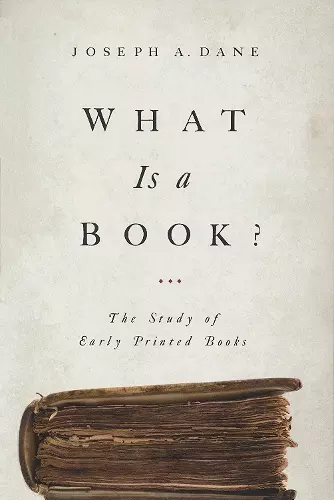What Is a Book?
The Study of Early Printed Books
Format:Paperback
Publisher:University of Notre Dame Press
Published:30th Mar '12
Should be back in stock very soon

Joseph A. Dane’s What Is a Book? is an introduction to the study of books produced during the period of the hand press, dating from around 1450 through 1800. Using his own bibliographic interests as a guide, Dane selects illustrative examples primarily from fifteenth-century books, books of particular interest to students of English literature, and books central to the development of Anglo-American bibliography. Part I of What Is a Book? covers the basic procedures of printing and the parts of the physical book—size, paper, type, illustration; Part II treats the history of book-copies—from cataloging conventions and provenance to electronic media and their implications for the study of books.
Dane begins with the central distinction between a "book-copy"—the particular, individual, physical book—and a “book”—the abstract category that organizes these copies into editions, whereby each copy is interchangeable with any other. Among other issues, Dane addresses such basic questions as: How do students, bibliographers, and collectors discuss these things? And when is it legitimate to generalize on the basis of particular examples? Dane considers each issue in terms of a practical example or question a reader might confront: How do you identify books on the basis of typography? What is the status of paper evidence? How are the various elements on the page defined? What are the implications of the images available in an online database? And, significantly, how does a scholar’s personal experience with books challenge or conform to the standard language of book history and bibliography?
Dane's accessible and lively tour of the field is a useful guide for all students of book history, from the beginner to the specialist.
“Dane writes with a clarity that will make this book useful to beginning students, yet with a wealth of examples that can instruct the most experienced scholar. At each stage the book is peppered with warnings about common errors and misconceptions that make it lively reading indeed.” —Sixteenth Century Journal
“. . . an introduction to the material aspect of Western printed books from the fifteenth to the beginning of the nineteenth century. Though this is a well-worked topic, Dane offers a contribution that exhibits several exceptional strengths. . . . Readers also will be pleased with Dane’s discussion of books in digital format and will welcome the extensive bibliography. The subject matter may be old, but the treatment is very up-to-date.” —Choice
“Dane turns to typography, illustrations, bindings, and other page-surface specific aspects of the book, which could have been written only by a person who had spent a lifetime examining books and investigating the methods for transferring ink to paper. He is especially good (and personable) on the provenance of books and the way owners leave marks on them.” —SHARP News
“. . . contributes to the scholarly field by providing a concise narrative introduction to a field which is inundated by works with similar goals. Used in conjunction with other texts, it certainly will provide a preliminary engagement with somewhat technical language and issues surrounding the field of bibliography.” —Comitatus
"Written with wit and acuity, Joseph A. Dane's What Is a Book? extends his project of teaching aspects of book history to the specialist and nonspecialist reader alike. Both will be stimulated and provoked by what Dane writes, and will also enjoy his arguments and admire the breadth and depth of his knowledge." —Henry Woudhuysen, University College London
"Joseph A. Dane is one of our most brilliant and prolific scholars of the early book, and this volume culminates a lifetime of research. For the general reader, it will offer a compelling survey of book history and book making. For the specialist, it will offer insights into the techniques of printers and the lives of collectors. For anyone concerned with how we read the past, and for anyone fascinated by the book as typographical artifact, What Is a Book? will be deeply valued. As Dane himself says in his introduction, 'never close a book without knowing more than you did before opening it.' I never close a book of his without knowing more than when I opened it, and this one is no exception." —Seth Lerer, University of California at San Diego
"Joseph Dane's What Is a Book? is a remarkable introduction to the study of books as physical objects. It is at once impressively learned and endearingly personal, displaying the fundamental characteristics of all of Dane's work: careful observation, rigorous thinking, and clear and energetic writing. Dane demonstrates what a book is, how it was made, and, perhaps most importantly, how its materiality gives witness to various histories that complicate and enrich our sense of what books mean and why they matter." —David Scott Kastan, Yale University
ISBN: 9780268026097
Dimensions: 229mm x 152mm x 20mm
Weight: 532g
294 pages